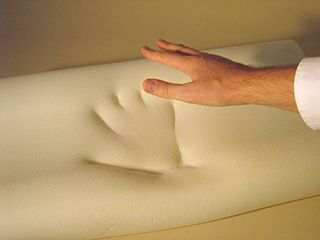Related Research Articles

A roof is the top covering of a building, including all materials and constructions necessary to support it on the walls of the building or on uprights, providing protection against rain, snow, sunlight, extremes of temperature, and wind. A roof is part of the building envelope.

A floor is the bottom surface of a room or vehicle. Floors vary from simple dirt in a cave to many layered surfaces made with modern technology. Floors may be stone, wood, bamboo, metal or any other material that can support the expected load.
Flooring is the general term for a permanent covering of a floor, or for the work of installing such a floor covering. Floor covering is a term to generically describe any finish material applied over a floor structure to provide a walking surface. Both terms are used interchangeably but floor covering refers more to loose-laid materials.

In camping, a ground pad, sleeping pad, thermal pad, sleeping mat, or roll mat is lightweight pad, common among hikers, backpackers and budget travelers, often used in conjunction with a sleeping bag. Its purpose is to provide padding and thermal insulation. All types currently available use air as their primary form of insulation.

Soundproofing is any means of impeding sound propagation. There are several basic ways to reduce sound: increasing the distance between source and receiver, decoupling, using noise barriers to reflect or absorb the energy of the sound waves, using damping structures such as sound baffles for absorption, or using active antinoise sound generators.

An air mattress is an inflatable mattress or sleeping pad.

A mat is a hard floor covering that generally is placed on a floor or other flat surface. Mats serve a range of purposes including:

A radiant barrier is a type of building material that reflects thermal radiation and reduces heat transfer. Because thermal energy is also transferred by conduction and convection, in addition to radiation, radiant barriers are often supplemented with thermal insulation that slows down heat transfer by conduction or convection.

A mattress is a large, usually rectangular pad for supporting a lying person. It is designed to be used as a bed, or on a bed frame as part of a bed. Mattresses may consist of a quilted or similarly fastened case, usually of heavy cloth, containing materials such as hair, straw, cotton, foam rubber, or a framework of metal springs. Mattresses may also be filled with air or water.

Memory foam consists mainly of polyurethane with additional chemicals that increase its viscosity and density. It is often referred to as "viscoelastic" polyurethane foam, or low-resilience polyurethane foam (LRPu). The foam bubbles or ‘cells’ are open, effectively creating a matrix through which air can move. Higher-density memory foam softens in reaction to body heat, allowing it to mold to a warm body in a few minutes. Newer foams may recover their original shape more quickly.

A flat roof is a roof which is almost level in contrast to the many types of sloped roofs. The slope of a roof is properly known as its pitch and flat roofs have up to approximately 10°. Flat roofs are an ancient form mostly used in arid climates and allow the roof space to be used as a living space or a living roof. Flat roofs, or "low-slope" roofs, are also commonly found on commercial buildings throughout the world. The U.S.-based National Roofing Contractors Association defines a low-slope roof as having a slope of 3 in 12 (1:4) or less.

A vapor barrier is any material used for damp proofing, typically a plastic or foil sheet, that resists diffusion of moisture through the wall, floor, ceiling, or roof assemblies of buildings and of packaging to prevent interstitial condensation. Technically, many of these materials are only vapor retarders as they have varying degrees of permeability.
A building envelope or building enclosure is the physical separator between the conditioned and unconditioned environment of a building, including the resistance to air, water, heat, light, and noise transfer.

Nonwoven fabric or non-woven fabric is a fabric-like material made from staple fibre (short) and long fibres, bonded together by chemical, mechanical, heat or solvent treatment. The term is used in the textile manufacturing industry to denote fabrics, such as felt, which are neither woven nor knitted. Some non-woven materials lack sufficient strength unless densified or reinforced by a backing. In recent years, non-wovens have become an alternative to polyurethane foam.

Building insulation materials are the building materials that form the thermal envelope of a building or otherwise reduce heat transfer.
Underlayment may refer to:

Pipe Insulation is thermal or acoustic insulation used on pipework.
A performance surface is a type of flooring with attributes suitable for dance or sport. The word performance in this context will refer to any means of displaying physical movement. This includes theatrical, athletic, and recreational forms of performance. However, these different disciplines all require specialized floors to accommodate their specific physicality. Performance surfaces are normally designed as a sprung floor with additional material or layers on top, to create a complete dance floor or sports floor. Dance performance surfaces are denoted by using a layer of Marley, a popular type of vinyl, on top of a sprung floor. Theatres often have a number of roll-out floors with different characteristics to satisfy the requirements of different forms of dance. In addition, athletic flooring has been found to require different and new technological mechanisms to enhance performance. Flooring for spaces like clubs or ballrooms also serves a different purpose and therefore utilizes different properties.
References
- 1 2 "Underlayment." The Oxford English Dictionary. 2nd ed. 1989.
- 1 2 "Underlay." The Oxford English Dictionary. 2nd ed. 1989.
- ↑ "Texfelt launches new eco-engineered underlay". Innovation in textiles. Archived from the original on 2019-11-04. Retrieved 2019-11-04.
- ↑ Australia, Home Improvement Pages. "Bedding Underlay". Home Improvement Pages. Archived from the original on 2019-08-25. Retrieved 2019-08-25.